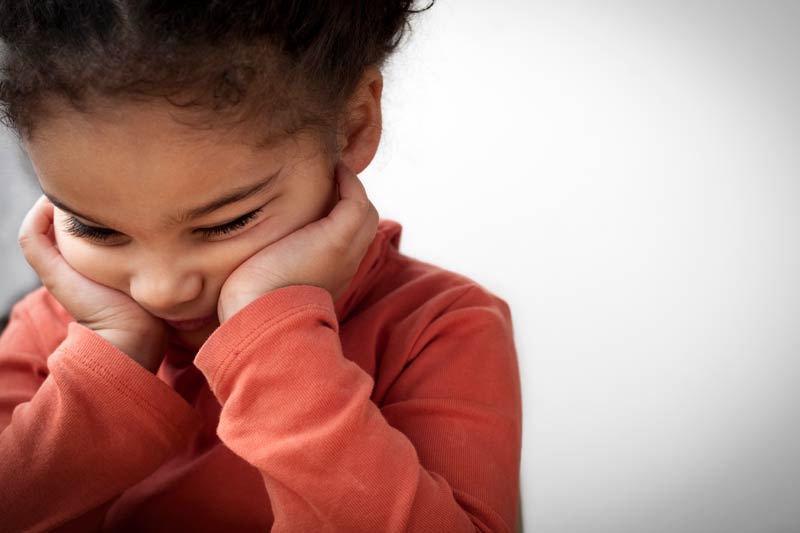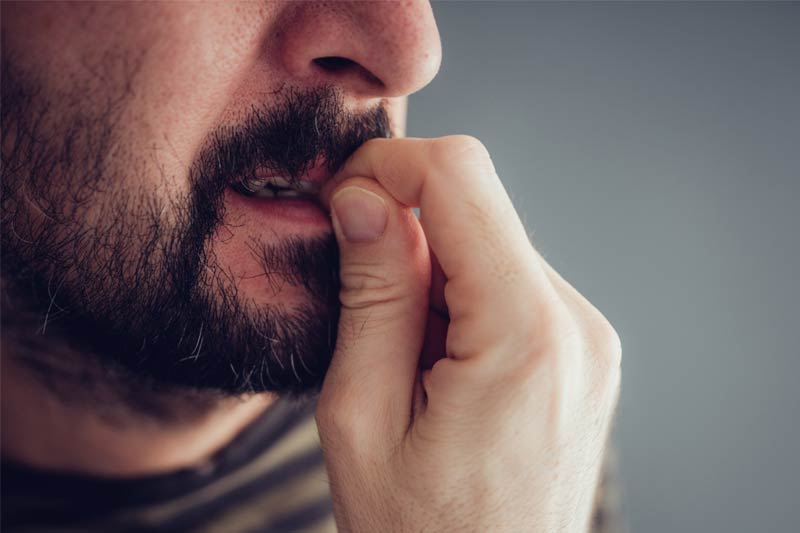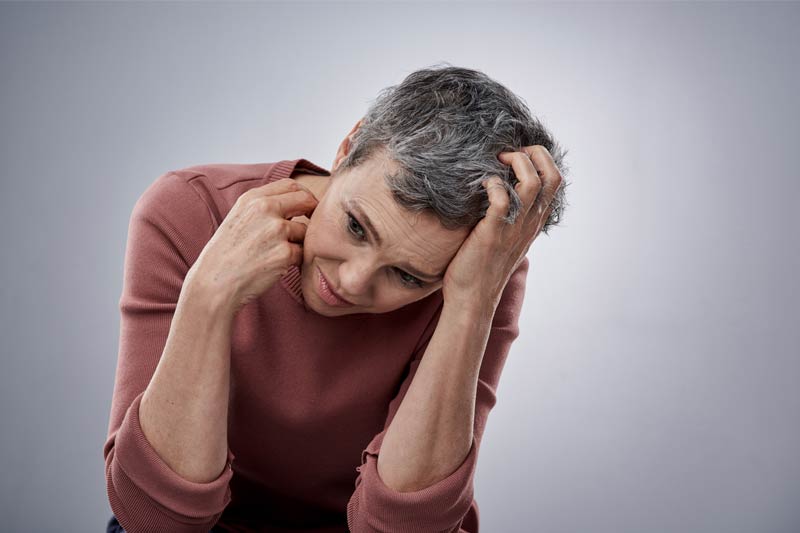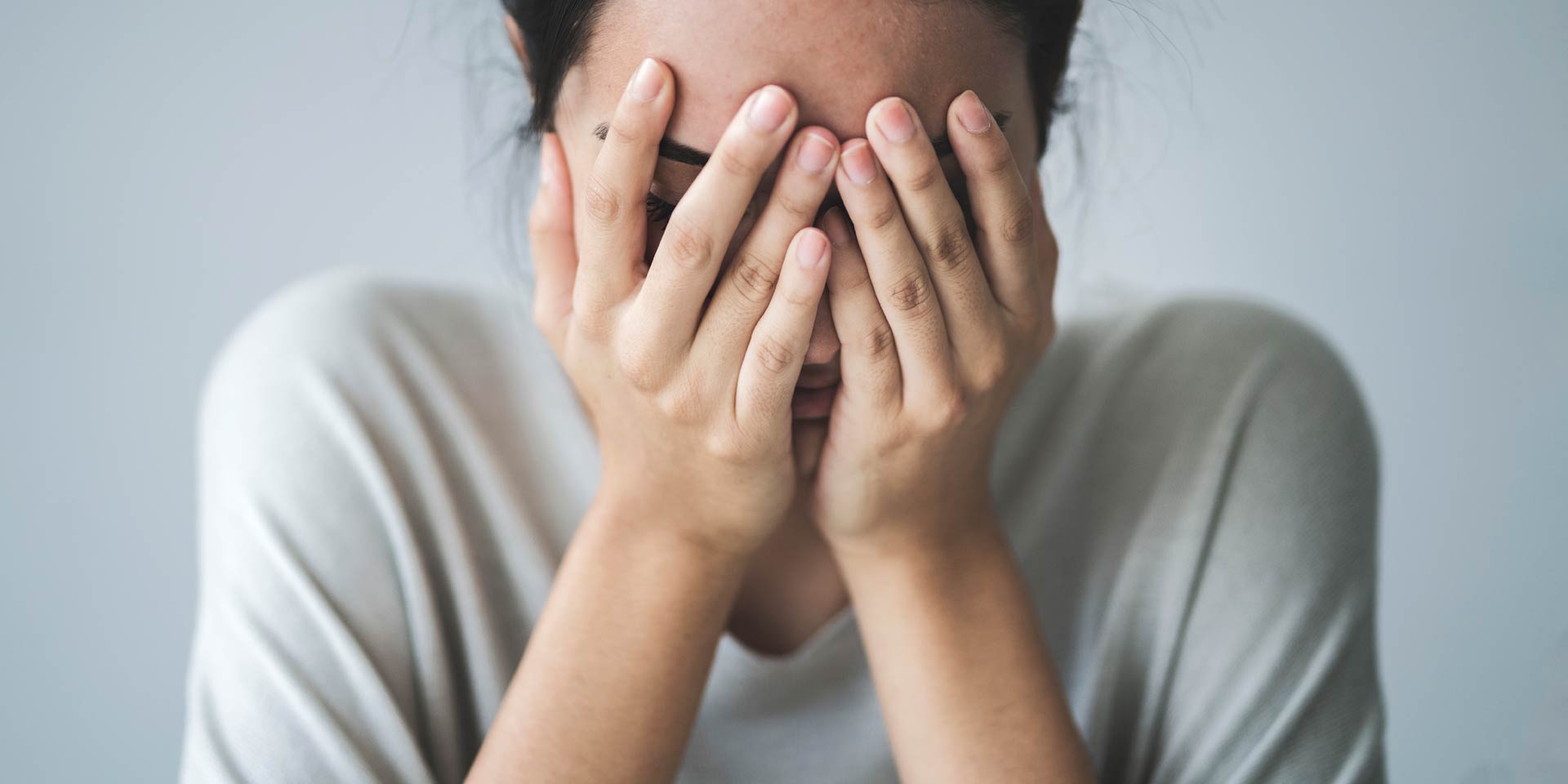“You are always afraid people will judge you or know your weakness. It’s like being totally naked in front of a huge crowd,” says Bruno Feldeisen about the hidden struggle he had with anxiety.
At just 22, after managing to get a job as a chocolate maker in the restaurant of the famous master chef Alain Ducasse, Feldeisen left for America, where his passion for pastry would propel him into the ranks of the top 10 chefs in the United States. At the age of 34, however, his first panic attacks began. Feldeisen initially thought it was a heart attack, but it was his mind, not his heart, that was caught in the vice of suffering.
As his symptoms progressed, the famous chef gave up going out in public, neglected his job and went bankrupt. “I didn’t like life anymore” was how he summed up his experience—shame and a feeling of weakness meant that he postponed seeking help.
Gail Andrews served as chief executive officer of a leading Canadian accounting firm. In her middle age, Andrews mastered three languages, was involved in sports and had great musical talent. Her strengths did not prevent her from feeling like an “impostor” and a real “fraud”. The usual situations at her job, from presentations to phone calls, were causing her anxiety. Therefore, she could never relax, and she was convinced that no one would like her if they really knew her.
Feldeisen and Andrews are just two of the millions of people in the world who face anxiety in its various forms. Experts are talking about a real anxiety epidemic of the modern world, with increasingly younger victims, who find themselves caught in the grip of excruciating symptoms they mistakenly attribute to somatic diseases.
The major anxiety types
The year 1983 marked a turning point in the history of diagnosing anxiety: the American Psychiatric Association issued the DSM-3 (Diagnostic and Statistical Manual of Mental Disorders), which treats depression and anxiety as independent conditions, describing several forms of anxiety.
The most common form is generalized anxiety disorder, which can interfere with a person’s ability to function effectively. It is associated with a wider range of physical symptoms (including sleep problems, fatigue, agitation, and severe muscle tension).
The condition usually begins in late adolescence, although many people have reported experiencing symptoms since childhood. These symptoms tend to be chronic, but can intensify during periods of stress. People who suffer from generalized anxiety disorder are more likely to develop other types of anxiety or mood disorders.
The cause of generalized anxiety may be identical to that of common anxiety (financial, work-related, health, etc.), but people with this condition have concerns about a wider variety of topics, sometimes reporting that “they are afraid of everything”. Also, the worrying experienced in the context of generalized anxiety disorder tends to be more frequent, more intense, disproportionate to the situation that triggers it, and less controllable.
Social anxiety disorder is a mental health problem that involves irrational fear of everyday social situations, in which the person feels constantly evaluated and judged by others, being convinced that they will be laughed at or humiliated. People with this type of anxiety want to be accepted by others, but have an intense fear that they could be assessed negatively. In the 1990s, the name of the disorder was changed from “social phobia” to “social anxiety disorder”, with researchers establishing that phobia involves the fear of a precise situation, while the fears of social anxiety encompass a wider scope (public speaking, social interactions, phone calls, etc.).
Panic disorders interfere with daily activity, being diagnosed in people who frequently experience panic attacks. Most panic attacks last between 5 to 20 minutes, have a different frequency (from once a month to several attacks per week, or day) and can be frightening to the person concerned. Common symptoms include tachycardia, excessive sweating, fainting, chest pain, shortness of breath, chills, and fear of death.
Phobias are manifested through an irrational fear that causes the person to avoid certain objects, events, or situations that do not represent a real danger, such as animals, elements of the environment, narrow spaces, and so on. In order to establish the diagnosis of a phobia, the fear must be intense and lasting, interfere with the normal functioning of the person, be activated in case of exposure to the stimulus and be described by the victims themselves as irrational.
The spectrum of anxiety disorders also includes post-traumatic stress disorder and obsessive-compulsive disorder. Post-traumatic stress disorder is triggered by experiencing a terrifying event, and the symptoms of this condition must last more than a month and be severe enough to interfere with relationships or the person’s usual routine to be able to establish this diagnosis. The symptoms of this condition consist of intrusive memories (nightmares or reliving the traumatic event), avoiding thoughts and conversations about trauma, negative changes in thinking patterns and mood, and changes in physical and emotional reactions (self-destructive behaviour, sleep, and concentration problems, aggressive behaviour and shame/overwhelming guilt).
Obsessive-compulsive disorder is manifested through obsessive thoughts, ideas, and sensations that pressure the person to adopt repetitive behaviours, such as washing one’s hands or checking things to reduce stress or prevent a much-feared situation.
Looking at anxiety through the lens of statistics
In 2002, the World Mental Health Survey (supported by the World Health Organization, Harvard University, and the University of Michigan) reported anxiety as the most prevalent condition worldwide.
Anxiety disorders affect 40 million American adults, or about 18.1% of the population. Also, 25.1% of children between the ages of 13 to 18 suffer from anxiety, and research shows that, in the case of children who do not receive treatment, the risk of poor educational results and substance abuse increases. Although anxiety disorders are treatable conditions, statistics show that only 36.9% of those suffering from some form of anxiety receive treatment. Anxiety costs the United States more than $42 billion a year; that is, nearly a third of the total mental health spending budget in the United States, according to a 2002 study.

A 2018 survey conducted by the American Psychiatric Association showed that American anxiety is on the rise: 39% of respondents said they are experiencing more anxiety than in the previous year, while 39% said their anxiety has remained at the same level of intensity. The national anxiety score (on a scale of 0 to 100) rose to 51, increasing by 5 points, compared to 2017. “This poll shows US adults are increasingly anxious, particularly about health, safety, and finances. That increased stress and anxiety can significantly impact many aspects of people’s lives, including their mental health, and it can affect families”, said Anita Everett, president of the American Psychiatric Association.
Anxiety is the most common mental disorder among people in the European Union (annually, 14% of Europeans face anxiety) as well, according to a study[1] published in 2011, which also revealed other conditions that Europeans struggle with: insomnia (7%), major depression (6.9%), drug and alcohol addiction (4%), ADHD in children (5%), and dementia (1-30%, depending on age). The study operated with data collected from all EU Member States, but also from Switzerland, Iceland and Norway.
While anxiety disorders affect all generations, a number of studies and surveys show that anxiety has become an epidemic among millennials.
Anxiety, the emblem of younger generations
The most anxious generation is the millennials, while the baby boomers report the lowest levels of anxiety, according to the American Psychiatric Association.
Also, over 52% of millennials report having at least one sleepless night caused by stress in the last 30 days, compared to 48% of Generation X, 37% of baby boomers, and 25% of those over 67 years old.
More and more students are turning to mental health services, according to a report containing data on 100,000 students, compiled by the Center for Collegiate Mental Health, founded by the Counselling and Psychology Service of Pennsylvania State University. According to the report, 1 in 2 students sought counselling, 1 in 3 took medication prescribed by a psychiatrist, 1 in 3 seriously considered suicide (and 1 in 10 even had an attempt), and 1 out of 10 was hospitalized for psychiatric reasons.
Anxiety was the first problem (seconded by depression) in a top 10 list of the symptoms reported by students arriving at clinics on university campuses. “A lot are coming to school who don’t have the resilience of previous generations. They can’t tolerate discomfort or having to struggle. A primary symptom is worrying, and they don’t have the ability to soothe themselves”, says Dan Jones, director of psychological counselling at Appalachian State University in Boone, North Carolina.
Therapists say treating anxiety has become a challenge for campus mental health services. Thus, the counselling centre of the University of Central Florida recorded, in 2015, an increase of over 15% in the number of students using its services, so it was necessary to turn some closets into therapy offices. This is not a unique case, occurring only in American universities.
There are a number of explanations for the unusual onslaught of anxiety, from growing academic pressure from an early age to overly protective parents, and addiction to digital devices. In essence, however, the culprit is modern society, which brings us a number of advantages and benefits, but is increasingly unfavourable for mental health. Or at least, that’s what some experts say.
The vines of anxiety easily entangle the trunk of modern society
While for epidemiologists, depression and anxiety are medical conditions, anxiety is increasingly taking the form of a sociological problem, becoming “a shared cultural experience that feeds on alarmist TV graphics and metastasizes through social media”, says journalist Alex Williams, in an analysis published in The New York Times.
The snowballing number of anxiety-related issues are explainable to Kai Wright, host of the WNYC United States Anxiety podcast. “We’ve been at war since 2003, we’ve seen two recessions. Digital life alone has been a massive change. Work life has changed. Everything we consider to be normal has changed. And nobody seems to trust the people in charge to tell them where they fit into the future”, Wright says.

Even beyond the ever-changing economic and political climate, modern life does not appear to be fertile ground for robust mental health, says Jean Twenge, who teaches psychology at the San Diego State University. Despite the fact that “in a lot of ways our lives are much easier than, say, our grandparents’ or great-grandparents’ lives”, the paradox is that we suffer more than ever from depression and anxiety.
Twenge advances three ideas about the potential causes of this paradox: 1) focusing on goals such as money, fame, and image (studies confirm the link between materialism and increased anxiety)[2]; 2) a high level of expectation and exigency, based on the belief that “you can be everything you want to be”; and 3) the removal of the psychological and social anchors that supported past generations.
Mobility and the thinning of relationships
The main problem of our time is that “modern life doesn’t give us as many opportunities to spend time with people and connect with them, at least in person, compared to, say, 80 years ago or 100 years ago”, Jean Twenge says. Evoking the example of her maternal grandmother, who raised seven children and worked hard on the family farm, the researcher points out that she “was virtually never alone—and that can be a bad thing, clearly, but from a mental health perspective being surrounded by people is a good thing.”
People who have a family or close friends to provide them with emotional support in times of crisis face a lower degree of stress. This was the conclusion of the 2015 Stress in America survey conducted by the American Psychological Association. However, millennials are the most mobile of all generations; more than 40 percent of millennials live far from their hometown, according to a Rent.com survey.
After a slalom between figures and studies linking isolation to increased anxiety, journalist Karol Markowicz says we are wrong when we do not tell children that it will be easier for them to place smaller geographical distances between themselves and their families. “That’s what I’ll tell my kids: It’s good to have the choice of living far from home—but it doesn’t mean it’s the right choice”, Markowicz says.
Caught in an endless maze of choices
A simple shopping session at the supermarket can become frustrating and unsettling when you have to choose between 47 varieties of ketchup and hundreds of brands of chips. The fact that Amazon sells you 119,265 types of toilet brushes and there are over 650 TV channels to choose from is not really a blessing, Dillon Knight Kalkhurst, an expert at Intergenerational Engagement, who helps companies and NGOs manage intergenerational communication, says both humorously and with concern.
“As the number of options increases, the costs, in time and effort, of gathering the information needed to make a good choice also increases. The level of certainty people have about their choice decreases. And the anticipation that they will regret their choice increases”, says psychologist Barry Schwartz. He claims that, with the inflation of choices, anxiety sets in, while the happiness of the individual decreases.
The fear that there are better options is deeply rooted in the minds of millennials, which causes a paralyzing effect on the individual, because they know that opening one door means closing dozens or hundreds of others, often irreversibly. That’s why, rather than entering through a door, they choose to sit in the doorway and watch. The choice to postpone choices is, in fact, just a shortcut to even more anxiety.
There are, however, other factors that explain the explosion of anxiety in modern society and especially among young people—factors that refer to a lifestyle that keeps us connected to everything new around us, but more and more disconnected from what is happening inside us.
When the details affect the whole picture
The fact that we are so casually neglecting sleep could be a key factor in the intensification of anxiety, according to researchers at the University of California, Berkeley campus. Lack of sleep “may play a key role in ramping up the brain regions that contribute to excessive worrying”, according to a study published in 2013.
While an adult should sleep 7 to 9 hours a night, 40% of Americans sleep less than 7 hours, compared to the 1940s, when only 11% of Americans slept insufficiently. On average, Americans sleep one hour less than in 1942. Teenagers also sleep less and less, and this could be one of the reasons why their generation is very mentally vulnerable, being on the verge of “the worst mental-health crisis in decades”, Jean Twenge says.
A study by Twenge and psychologist Zlatan Krizan, which processed data collected from 360,000 teens, shows that 40% of teens slept less than 7 hours a night (given that psychologists recommend 9 hours of sleep for teens) and sleep deprivation is increasing by 17%, compared to 2009, and 58%, compared to 1991.[3]

Smartphone addiction is one of the key causes of insufficient sleep. On average, Americans check their phones 46 times a day, and those in the 18-24 age group check their phones 74 times a day, according to a study by Delloitte. The fact that we no longer can step away from the phone screen does not only affect the quality and length of our sleep, but also amplifies our state of anxiety, according to studies conducted in 2014[4] and 2018.
Multitasking, connecting more and more devices from our homes to the internet and being able to be online 24 hours a day are new sources of anxiety, which overlap with traditional ones, says Graham Davey, anxiety expert and psychology professor at the University of Sussex. “Even that bastion of modern-day living, the computer, brings with it daily worrisome hassles that include crashing hard drives, forgotten passwords, and the frustration of daily transactions…when all we’d like to do is speak to a real person”, says Davey, who even speaks of “the curse of social media”.
Young people become worried when they follow the apparent success or prosperity of those present in the online environment, and then evaluate their own success “in terms of metrics”, for instance, the number of friends on social networks, while losing their real friends, who could support them in difficult times, Davey says.
It is risky to say that anxiety can be prevented in any situation (especially since it may relate to one’s genetics), but its profile may be easier to decipher than the Gordian knot we associate it with: beyond the convenience of modern life, the image of a lonely individual, troubled by the pressures of society, stuck in an endless roller coaster of competition and deprived of the security offered by family ties, friends, and community, is being outlined.
Perhaps all we need to learn, in a culture that treats anxiety almost as a symbol of efficiency and success, is that in order for a life to carry the mark of excellence, it is not necessary for it to fit perfectly into the narrow pattern that society validates. We don’t even have to face life’s crises in the folding chair of the self, while having abandoned the welcoming sofas of close relationships. As psychologist Martin Seligman says in his book, Learned Optimism, the old patriarchal society, with its benefits and inequalities, is gone—but this does not mean that we cannot sow the seeds of the ingredients responsible for a truly fulfilled life in the soil of modern society.



















